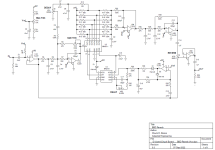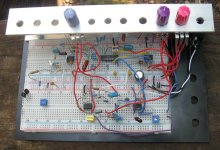Chuck D. Bones
Circuit Wizard
After being whelmed, but not overly, by the Belton Brick, I thought I'd give a BBD-based reverb pedal a try. I ran across a vintage MN3011 (U3) in my stash and this is what I ginned-up. It's mostly based on an example circuit in the datasheet, with a few extra features thrown in. The MN3011 has a total of 3,328 stages, with 5 taps along the way and an output at the very end. The taps are staggered to mimic the multiple reflections in a room. OUT6 is at the end of the line. All 6 outputs are combined, filtered and mixed with the dry signal. The signal at OUT6 is also fed back to the input of the BBD via the DECAY control. There is some filtering up front and a Gain Trim to compensate for the chip-to-chip insertion loss variation. U4 generates the clock using its internal oscillator. The DELAY control sets the clock rate. Based on our discussions of the Belton Brick's LFO dither, I went with Betty Wont's idea and used the guitar envelope to modulate the clock freq a little bit. It works quite well. The clock freq is always moving, but it's gradual and somewhat random, nudged along by the guitar's envelope. U5A is a slow peak detector that sort of follows the guitar's envelope. It pushes the clock freq up and down a few percent. This was the hardest part of the circuit to get right. I tried doing it a few different ways with fewer parts, but nothing work anywhere near as well as this version. I might make a few component value tweaks, but the basic topology is solid. I'll snap a pic of the breadboard tomorrow AM after the sun comes out.





